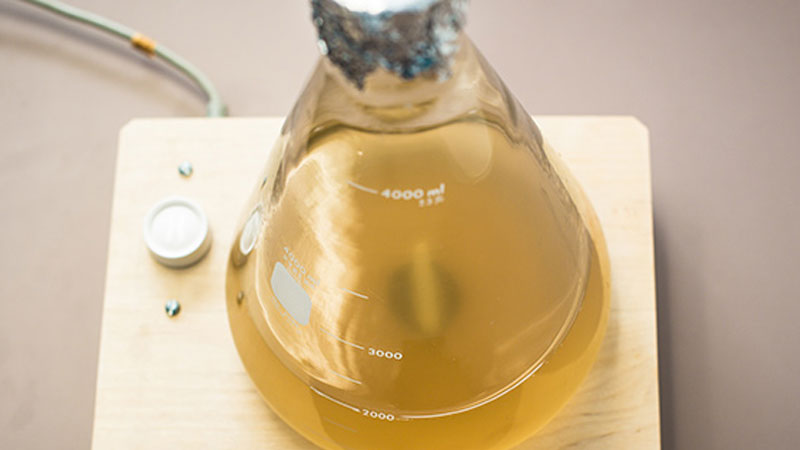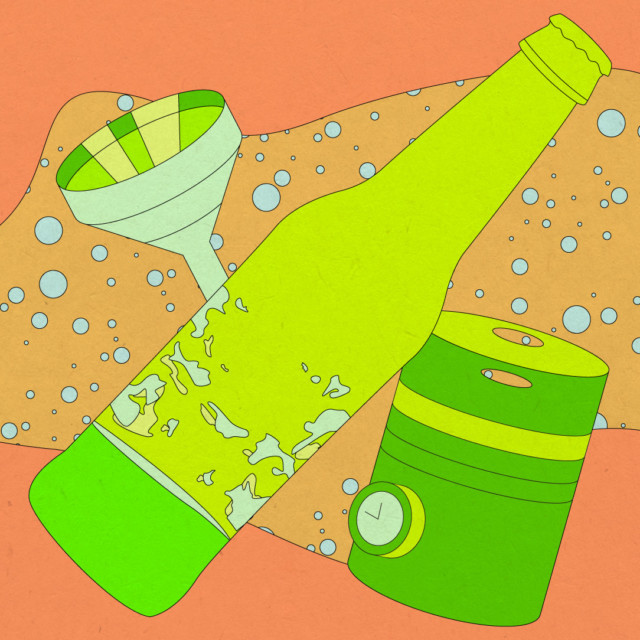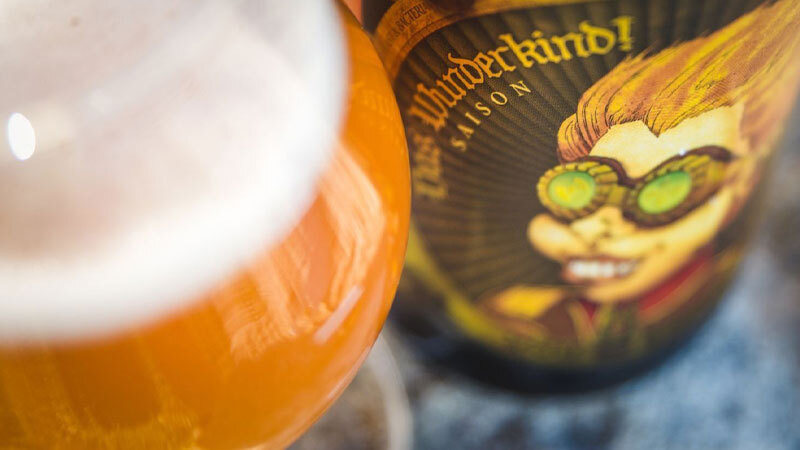Dregs, the unappealing sludge of yeast and sediment that settles on the bottom of unfiltered beers, is often best left in the bottle. That is, unless you’re a homebrewer — if you’re ready to get creative, those nearly empty bottles can be your next source for ingredients.
Homebrewing with dregs is certainly risky. But for those without restrictions of time, space, and expectations, this is where the fun and experimentation begins.
Four professional brewers break down the good, the bad, and the really, really funky that comes with brewing and fermenting with leftover dregs. Hear from the pros at Oxbow, Keeping Together, Jester King, and Cascade on whether dregs are worth your while.
To Dregs or Not to Dregs?
“If your goal is to make the very best beer possible, using dregs can have a lot of pitfalls,” says Kevin Martin, director of brewery operations at Cascade Brewing in Beaverton, Ore. That’s because without a lab, it’s impossible to determine exactly what lives in this slurry, and how much life it has left in it — or what pro brewers refer to as “viability.”
The team at Jester King Brewing in Austin, Texas, is enthusiastic about using dregs as a homebrewer. “This approach aligns with our brewing philosophy of being creative and innovative, as well as sustainable,” Jeffrey Stuffings, co-founder of Jester King, says.
Averie Swanson, Master Cicerone and founder and beermaker at Keeping Together, a Chicago-based beer brand that focuses on mixed-culture and mixed-fermentation saison, has similar thoughts on DIY propagation. “The results of fermenting with a culture that has been propped [propagated] from bottle dregs can vary, but generally I would say that this can be a really fun and interesting thing to do,” she says.
Swanson also points out that harvesting yeast from bottles can be a cheaper alternative to buying packs of yeast at a homebrew supplier. But, importantly, it’s only less expensive if you select your dregs carefully; otherwise, you may end up with the costly result of an entire infected batch of beer.
Other pros like Tim Adams, founder of Oxbow Brewing Company, are cautious in their encouragement of dumping dregs into homebrew. He says if a brewer is comfortable with introducing “wild and non-wild yeast into their beer in a relatively unpredictable manner, then it’s a fine idea.”

Selecting Dregs
When determining which bottle dregs to use in your experiments, there are definite characteristics to avoid.
The easiest to identify as ones to avoid are beers that are dry hopped, highly hopped, or have fruit additives. Hops inhibit yeast growth, so an already weakened strain from dregs doesn’t have a good chance at fermenting again. Fruit throws off the acid balance in the beer and can also create a less-than-ideal environment for yeast.
Stuffings recommends avoiding dregs from highly acidic beers, or beers with acetic acid present (anything with faint notes of vinegar on the nose). It only takes a few cells or acetobacter, the bacteria that produces acetic acid, to grow and turn a whole batch into vinegar. This goes for many bacteria that can be found in funky beers.
Adams reminds brewers to ask themselves, “How much of an unintentional introduction would it take to infect [the] beer?” His answer: Not much at all. Even just a few cells of a bacteria or yeast can have an outsized impact on beer flavor.
Because of these risks, it is advisable to brew with dregs from bottles containing yeast and bacteria that aren’t available commercially or are from special bottles that are hard to come by like Cantillon gueuze or Fantome saisons. Other examples include Jester King’s three-year blend SPON, which uses a house culture; or Keeping Together beers such as The Art of Holding Space, a table saison. Swanson works with the yeast wranglers at Escarpment Labs on her cultures.
For example, Martin had just one experiment brewing with dregs when he was a homebrewer before he was brewing professionally at Cascade. He attempted to recreate Widmer Brothers Brewing Hefe using only the dregs from a 6-pack of the popular wheat beer. Since hefeweizens and other weissbiers and unfiltered beers would have yeast in the bottle that could be used for brewing, but the viability of that yeast was unknown. Martin says his experiment was “moderately successful” but the results would have been easier to achieve with a commercially available yeast.
The final aspect to consider is if the brewery pasteurized the beer before packaging, or if a different yeast strain is used for bottle conditioning.
“We [Cascade] do bottle condition with a Champagne yeast,” says Martin. “If you use our dregs and it starts to become really active, chances are very, very high that what you have is a Champagne yeast fermentation, more so than a Cascade sour.”
The best way to get information on the filtering and conditioning practices for a specific beer is to contact the brewery yourself. Swanson uses the same house culture for bottle conditioning that she uses to ferment, so her dregs are easy to brew with — but she is in the minority when it comes to commercial brewers. She says, “If you are specifically looking for the yeast character of a certain brewery, you would want to confirm that the yeast present in the bottles for conditioning is in fact the house culture of the brewery.”
Stuffings recommends the Mad Fermentationist blog created by Michael Tonsmeire listing unpasteurized bottles; although the site is no longer updated, it’s a good resource for brainstorming recipes and is referenced by homebrewers in social media groups, including Milk the Funk.
Preparing Dregs
As stated, there is no way to know how many yeast cells remain alive at the bottom of a bottle. Because of this, many pro brewers suggest making a yeast starter. Starters act as a mini-fermentation to get yeast active and multiplying, and to increase overall vitality.
Martin says that when making a starter for dregs, it’s best to make the starter wort very high in complex sugars. If you’re an all-grain homebrewer, this is easy to do with a high temperature mini-mash (high temperatures, especially over 160 degrees Fahrenheit, will stop the actions of enzymes that break down starch into easily fermentable sugars) — leaving behind lots of complex sugars and dextrins. This is because wine yeast or bottle-conditioning ale yeast will eat through the easily fermentable sugars first, but can’t digest dextrins. The slower-growing bacteria will be able to “nibble at” these complex sugars as it slowly grows.
He says to expect any fermentation with dregs to have a “longer lag phase,” meaning it will take more time to see fermentation activity like bubbling and foaming.
Want a Funky Beer With More Reliability Than Dregs?
There’s no need to rely on dregs for an interesting, funky homebrew. As Adams says, for homebrewers looking to take the guesswork out of making beers with dregs, “Support your local homebrew store! They should have plenty of brett [brettanomyces] and bacteria for sale.” He adds, “It’s quite a bit more predictable that way.”
Both Martin and Stuffings suggest Wyeast’s Roeselare Belgian Sour Blend for its complexity and reliability. For that Widmer Brothers Hefe that Martin tried to recreate back in his homebrew days, use White Lab’s American Hefeweizen yeast.
For less common, and a little more pricey, strains to create funk-forward farmhouse beers, Stuffings points to Community Culture Yeast Lab, where he sourced a “prickly pear” strain used in a saison. Swanson suggests using her yeast team at Escarpment Labs, which offers a catalog of unique yeast cultures to the public.
Don’t Expect to Clone a Commercial Beer
There are many aspects that impact the final flavor of a beer, from malt to fermenter geometry to water chemistry. Yeast and bacteria are just one factor. While there will be some flavor aspects that carry though from the original beer, many will be created by process and ingredients. Experimenting with dregs is about finding and creating those flavors more than it is perfectly recreating a commercial example.
Swanson believes experimenting with propagating yeast and bacteria is worthwhile, as well as illuminating; but “trying to create a beer (on a homebrew level or even in another brewery) that tastes exactly like the beer that inspired it, is almost impossible in my opinion,” she says.
That’s not to discourage the use of dregs. Adams remembers that “Oxbow’s very first wild brews were barrel- fermented with a variety of wild yeasts and bacteria harvested from lambic and Belgian mixed culture beers,” he says. If it’s good enough for the pros, it’s good enough for homebrewers.

